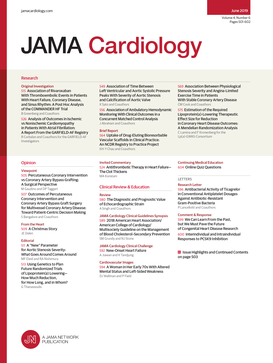2000-2020年美国黑人和白人的粮食不安全和心血管疾病事件
IF 14.8
1区 医学
Q1 CARDIAC & CARDIOVASCULAR SYSTEMS
引用次数: 0
摘要
食品不安全与流行的心血管疾病(CVD)有关,但研究仅限于横截面数据。目的研究食品不安全是否与心血管疾病事件相关,并确定这种关联是否因性别、教育程度或种族而异。设计、环境和参与者本前瞻性队列研究于2000年至2020年8月31日在没有心血管疾病的美国成年人中进行,这些成年人参加了CARDIA(年轻人冠状动脉风险发展)研究。数据分析时间为2022年12月至2024年4月。食品不安全,定义为认可2000-2001年期间评估的家庭食品种类和/或食品数量的限制。主要结局和测量主要结局是CVD事件,包括致命性和非致命性冠心病、心力衰竭、中风、短暂性脑缺血发作或外周动脉疾病,每年确定至2020年8月31日。结果3616名参与研究的成年人平均(SD)年龄为40.1(3.6)岁,其中2027名(56%)为女性。在3616名参与者中,1696名(47%)自我报告为黑人,529名(15%)参与者在基线时存在食品不安全。食品不安全的人更有可能自我认同为黑人,并报告较低的受教育程度。平均(SD)随访期为18.8(3.4)年,在此期间发生了255起心血管疾病事件:在研究期间,食物不安全参与者发生了57起事件(11%),食物安全参与者发生了198起事件(6%)。在调整了年龄、性别和场地中心因素后,食物不安全与心血管疾病的发生相关(校正风险比[aHR], 1.90;95% ci, 1.41-2.56)。相关性持续存在(aHR, 1.47;95% CI, 1.08-2.01),在进一步调整教育、婚姻状况和通常医疗来源等社会经济因素后。在CARDIA研究参与者的前瞻性队列研究中,即使在调整社会经济因素后,食品不安全仍与CVD事件相关,这表明食品不安全可能是临床评估CVD风险的重要社会剥夺指标。减少粮食不安全的干预措施是否能潜在地缓解心血管疾病还有待进一步研究。本文章由计算机程序翻译,如有差异,请以英文原文为准。
Food Insecurity and Incident Cardiovascular Disease Among Black and White US Individuals, 2000-2020
ImportanceFood insecurity is associated with prevalent cardiovascular disease (CVD), but studies have been limited to cross-sectional data.ObjectivesTo study whether food insecurity is associated with incident CVD and to determine whether this association varies by sex, education, or race.Design, Setting, and ParticipantsThis prospective cohort study was conducted among US adults without preexisting CVD participating in the CARDIA (Coronary Artery Risk Development in Young Adults) study from 2000 to August 31, 2020. Data analysis was conducted from December 2022 to April 2024.ExposureFood insecurity, defined as endorsing limitations in household food variety and/or food quantity, assessed in the period 2000-2001.Main Outcomes and MeasuresThe primary outcome was CVD events, consisting of fatal and nonfatal coronary heart disease, heart failure, stroke, transient ischemic attack, or peripheral arterial disease, identified annually through August 31, 2020.ResultsOf 3616 total participating adults, mean (SD) age was 40.1 (3.6) years, and 2027 participants (56%) were female. Of 3616 participants, 1696 (47%) self-reported Black race and 529 participants (15%) had food insecurity at baseline. Individuals with food insecurity were more likely to self-identify as Black and report lower educational attainment. The mean (SD) follow-up period was 18.8 (3.4) years, during which 255 CVD events occurred: 57 events (11%) in food-insecure participants and 198 events (6%) in food-secure participants over the study period. After adjusting for age, sex, and field center, food insecurity was associated with incident CVD (adjusted hazard ratio [aHR], 1.90; 95% CI, 1.41-2.56). The association persisted (aHR, 1.47; 95% CI, 1.08-2.01) after further adjustment for the socioeconomic factors of education, marital status, and usual source of medical care.Conclusions and RelevanceIn this prospective cohort study among participants in the CARDIA study, food insecurity was associated with incident CVD even after adjustment for socioeconomic factors, suggesting that food insecurity may be an important social deprivation measure in clinical assessment of CVD risk. Whether interventions to reduce food insecurity programs can potentially alleviate CVD should be further studied.
求助全文
通过发布文献求助,成功后即可免费获取论文全文。
去求助
来源期刊

JAMA cardiology
Medicine-Cardiology and Cardiovascular Medicine
CiteScore
45.80
自引率
1.70%
发文量
264
期刊介绍:
JAMA Cardiology, an international peer-reviewed journal, serves as the premier publication for clinical investigators, clinicians, and trainees in cardiovascular medicine worldwide. As a member of the JAMA Network, it aligns with a consortium of peer-reviewed general medical and specialty publications.
Published online weekly, every Wednesday, and in 12 print/online issues annually, JAMA Cardiology attracts over 4.3 million annual article views and downloads. Research articles become freely accessible online 12 months post-publication without any author fees. Moreover, the online version is readily accessible to institutions in developing countries through the World Health Organization's HINARI program.
Positioned at the intersection of clinical investigation, actionable clinical science, and clinical practice, JAMA Cardiology prioritizes traditional and evolving cardiovascular medicine, alongside evidence-based health policy. It places particular emphasis on health equity, especially when grounded in original science, as a top editorial priority.
 求助内容:
求助内容: 应助结果提醒方式:
应助结果提醒方式:


